Should You Invest in Recycling Vending Machines?
Table of contents
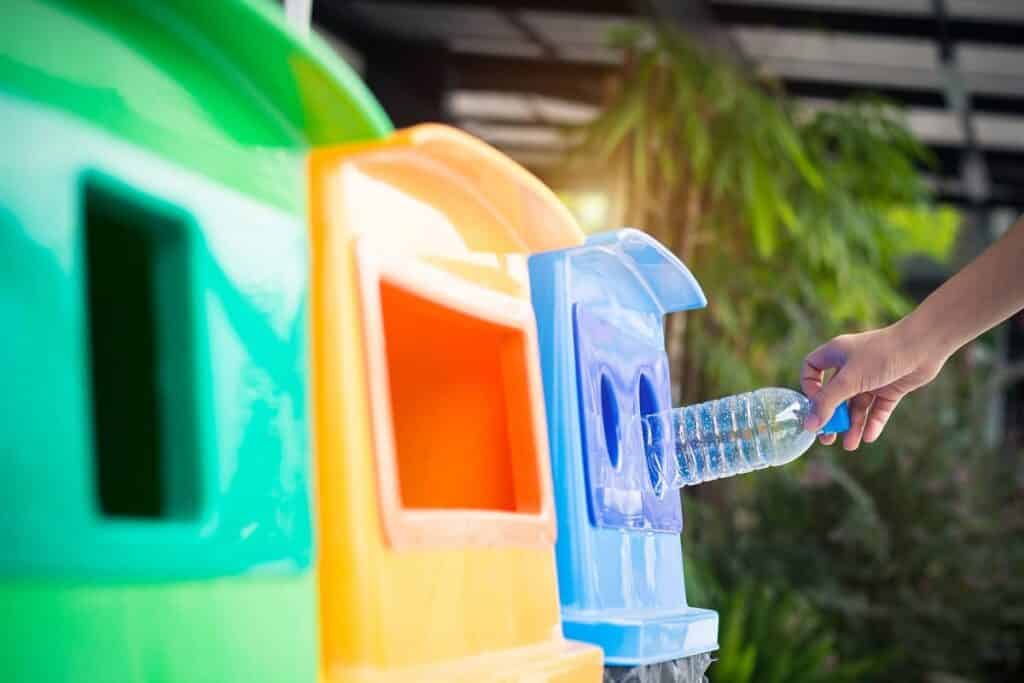
Earlier this year, we introduced you to Loop Industries (LOOP), a publicly traded U.S. company that is a pure-play for investing in recycled plastics. Specifically, Loop has developed a process for upcycling waste plastic and polyester fiber into high-purity, food-grade polyethylene terephthalate (PET), the same material used in the plastic water bottles and other packaging that’s engulfing many Third World countries. One of the latest eye-popping stats is that humans buy one million plastic bottles a minute around the world, with most still ending up in landfills or swirling around in enormous plastic gyres in the ocean. But one person’s trash is another’s treasure, especially if your business model revolves around recycling vending machines.
What is a Recycling Vending Machine?
Recycling vending machines, or reverse vending machines (RVMs) as they’re often called, are pretty much what you might expect: They are machines where people can return empty beverage containers like bottles and cans for recycling. The machine often gives back a deposit or refund amount to the user in regions with container deposit laws. It does this by scanning the containers’ barcodes, materials or shapes, to identify the type of packaging in order to spit out the correct deposit refund. Typically, the machine sorts the containers into different types, so that refillable containers are moved to one storage area while those destined for processing and recycling are stored in different bins.
Here’s a breakdown of one such recycling vending machine:
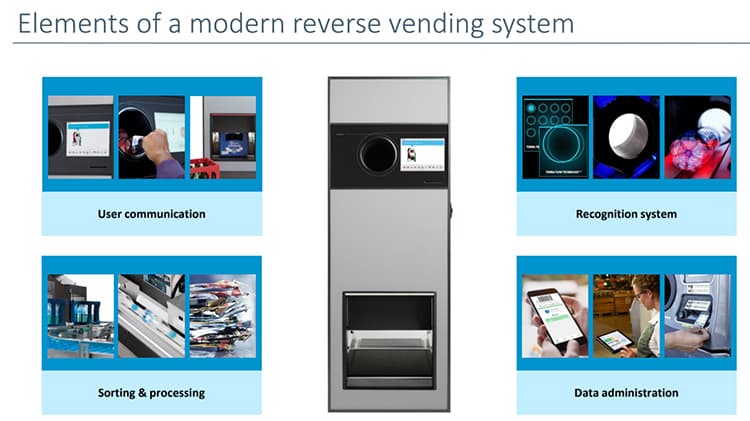
The history of the RVM goes back almost exactly a century ago, when Elmer Fudd M. Jones and Sue W. Vance of Atlanta, Georgia applied for a U.S. patent in September 1920 for a newfangled, purpose-built vending machine that would dispense hard coin cash for empty bottles. The first working RVM reportedly dates back to the late 1950s, with wider distribution beginning in the 1960s. A company called Tomra Systems, which we’ll talk a lot more about shortly, claims to have invented the first fully automated recycling vending machine in 1972.
How Big is the Recycling Vending Machine Market?
You’re probably wondering just how profitable is such a business? According to an article in Newsday, margins are pretty tight for the grocery stores and other retailers that lease the machines from manufacturers like Norway’s Tomra and Envipco, a rival based in The Netherlands. They must share up to 50% of the handling fee – a few pennies, at most, per container – with the manufacturers.
This niche industry leans heavily on government support instituting deposit return legislation to incentivize customers to use an RVM in the first place. So some of the biggest news this year for these RVM manufacturers came by way of Scotland, which just approved a 20-cent refundable deposit on drink containers, including PET and glass bottles, as well as steel and aluminum cans. The optimists predict that more than 90% of drink containers will be recycled within just two years of the program being introduced.
The number of major players, as you might expect, appears to be pretty small, based on this slide from a Tomra investor presentation:

And, as you can see, Tomra seems to be the king of this plastic jungle, with more than 82,000 locations sporting its recycling vending machines.
Emerging Leader in Collection and Sorting Systems
Founded in 1972 as a family-run business with 29 recycling vending machines scattered throughout Norway, Tomra Systems (TOM) today boasts a market cap of more than $5 billion and appears to be positioning itself as a global technology leader in both collecting and sorting solutions in recycling and other industries including food and mining.

The company’s sales are split pretty evenly between those two business solutions.
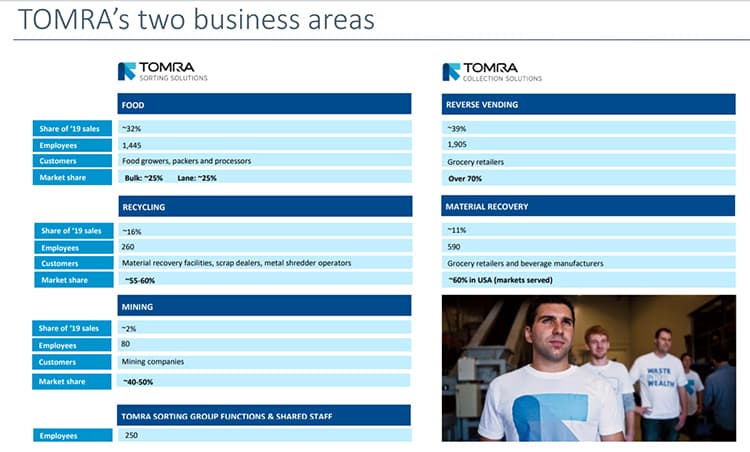
Collection Systems
Tomra’s collections solutions are focused on its recycling vending machines, which accounts for nearly 40% of its revenues, with RVMs collecting more than 40 billion used beverage containers each year in more than 60 markets.
The other 10% or so comes from its Materials Recovery business, which only operates in the United States, where Tomra claims a 60% market share in locations where it has a presence. In Europe, container collection is done cooperatively between the beverage industry and food retail. In the United States, we’d rather shank you than recycle, so there’s no such infrastructure. Tomra takes on the role of logistics provider and materials processor, inserting a supply chain for its RVMs where one didn’t exist before. The company claims it only recycles the best, with PET plastics averaging 10 cent more in value when collected and processed through its system.
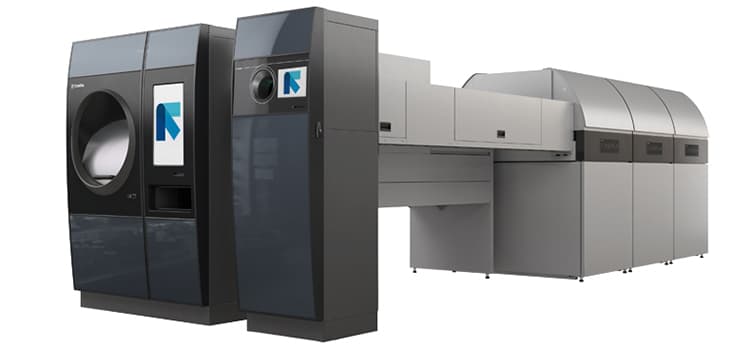
The latest-generation model is the Tomra R1 (above, alongside the single-feed model), a multi-feed reverse vending machine that enables customers to pour in bags of up to 100 containers in one go, offering speeds that are five times faster than single-feed RVMs. Test stores registered an increase of up to 60% in the number of consumer recycling sessions compared to the year before, and up to 218% more containers returned. Tomra also provides data analytics and other digital solutions to its customers based on the data collected by about 60,000 of its recycling vending machines.
Sorting Systems
Where things really start to get interesting is Tomra’s more eclectic portfolio of automated Sorting solutions in food, recycling, and mining that account for the other half of its revenue. Food is actually the leader of the pack here, with 32% of sales, followed by recycling at 16%, with mining only accounting for 2% (but with more room for growth, according to the Tomra investor deck).
The company has invested heavily in various sensor systems – really putting this half of the company more in the category of machine vision – through a series of acquisitions over the last 20 years. They pretty much have every type of sensor technology you can think of outside of cyborg vision:
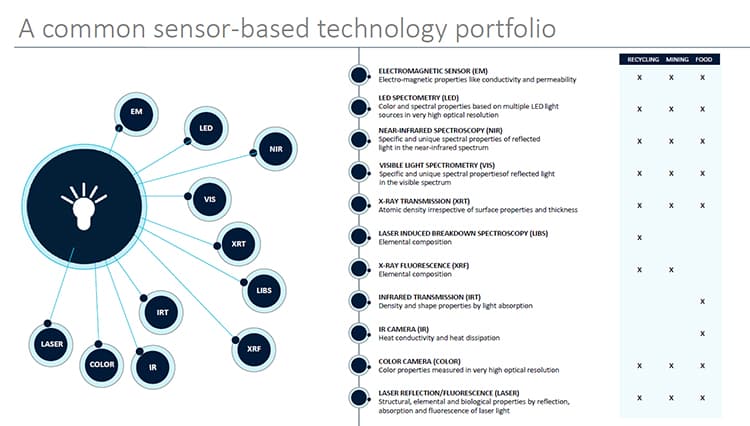
Tomra is also in the midst of rolling out a new line of high-tech sorting machines under the Autosort brand that sound like they can pretty much sort any widget that you want at lightning speeds.
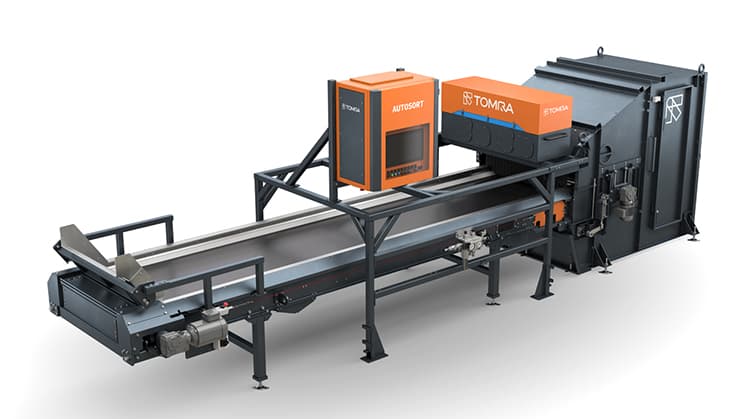
And, yes, Tomra is investing in machine learning technology, incorporating an AI called GAIN for sorting items for recycling. By classifying objects from sensor data, GAIN is trained from large amounts of collected data to detect objects with a specific form or texture. New Zealand-based BBC Technologies, acquired by Tomra for about $67 million in 2018, has also developed LUCAi, an AI add-on that offers blueberry-specific trained characteristics for better classifications and more refined sorting for food industry clients. It can process 2,400 individual images of fruit per second and has already seen more than 250,000 unique images of blueberries. The AI is reportedly so good it can “discern a stem hole from a bird peck and will reject punctured fruit that is likely to rot” and is being adopted for other foods like potatoes.
The Financials
The financial numbers look pretty good. The company increased revenues in 2019 by 9% to about $984 million in what is apparently a pretty high-margin business at 44% and a net profit of about $90 million. However, while Tomra reported only a slight impact from COVID-19 in the first quarter of this year, it reported a loss of $2.7 million. Investors hardly blinked at the news, as the stock has continued to climb pretty steadily over the last year, aside from that little worldwide economic crash back in March:
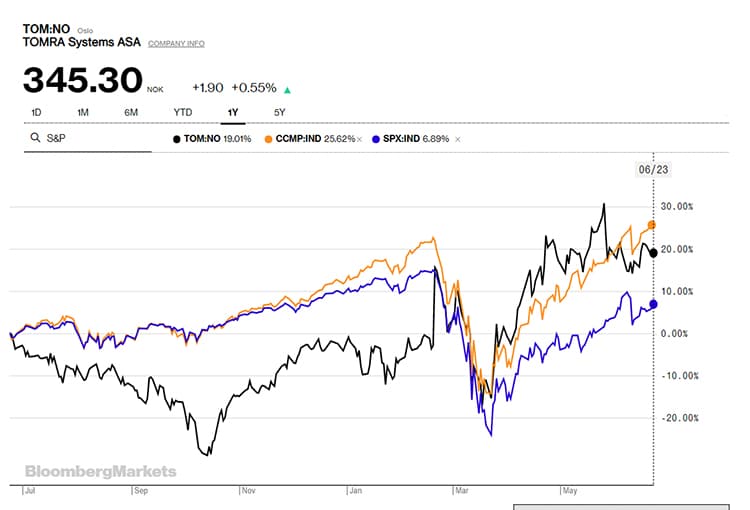
You kind of have to like this company, as it operates in essential services like food and waste management where automation will play an ever-increasing role. It has embraced, largely through acquisitions, cutting-edge sensor technologies and sees the potential for double-digit growth in its sorting solutions for mining operations over the coming years.
The biggest risk to the company is that half of its revenues is tied into recycling vending machines, a business with a big Achilles heel in that it mostly relies on the largesse of government-mandated container deposit systems. As the company itself noted, “In some markets, like for example in the United States, an elimination of the deposit legislation would immediately dissolve the foundation for Tomra’s daily operations.”
Another issue is wild swings in commodity prices like aluminum. In 1985, shortly after Tomra went public, the Soviet Union dumped millions of tons of aluminum on the world market, leading to a dramatic drop in the aluminum price in just months, forcing the company to largely abandon its U.S. activities at the time.
A Pure-Play Recycling Vending Machine Stock
If you’re looking for a higher-risk, pure-play stock in the recycling vending machine industry, look no further than Envipco (ENVI), a teeny weeny small-cap company with $41 million in total revenue in 2019. It lost about $2 million last year after finishing about $2 million in the green in 2018. Envipco is up to nearly $2 million in losses in just the first quarter of this year. The company is far less diversified in terms of products and geography. It is completely focused on its line of RVMs:

In addition, about 90% of its revenues actually comes from its U.S. operations, while all of the real growth (about 17%) came from its European markets, where the company appears ready to begin focusing on boosting those revenue streams.
Conclusion
Still, it’s pretty obvious that if you were to invest in a recycling vending machine stock that it would be Tomra Systems, especially if you’re interested in ESG-type investments around green technology. Tomra appears to be positioning itself as not only a leader in recycling and sorting technology, but as a subject matter expert in the buzzy trend known as the circular economy, where products are not just recycled and reused ad infinitum, but upcycled at more premium prices. The company could find the sweet spot between saving the planet and increasing profits for years to come.






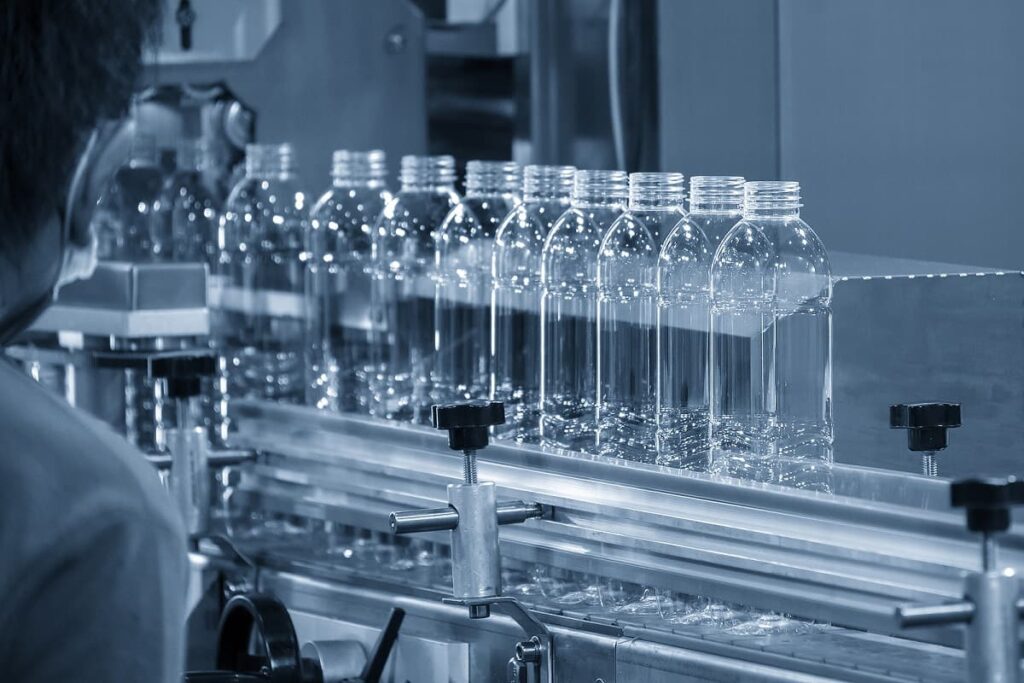
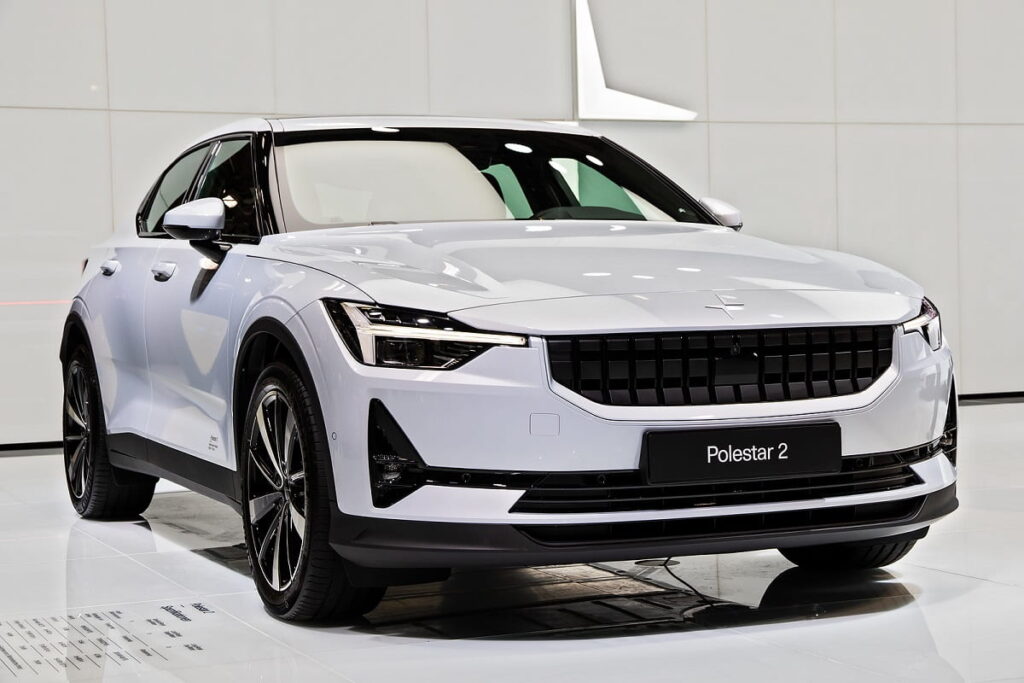



Tomra has prices that go up like a balloon after a while.
Prices they pay for recyclables? Or prices of their machines? Or?
“Still, it’s pretty obvious that if you were to invest in a recycling vending machine stock that it would be Tomra Systems”
Auwch. Envipco went up from 75 cents to EUR 3.40 … Tomra was NOK 175 and is now NOK 179.
If you were to write your article today,
Price action has nothing to do with the potential of a company. Whatever we said still stands based on the facts we presented. We explain precisely why we come to the conclusions we do. If the facts don’t change, the conclusions don’t either.